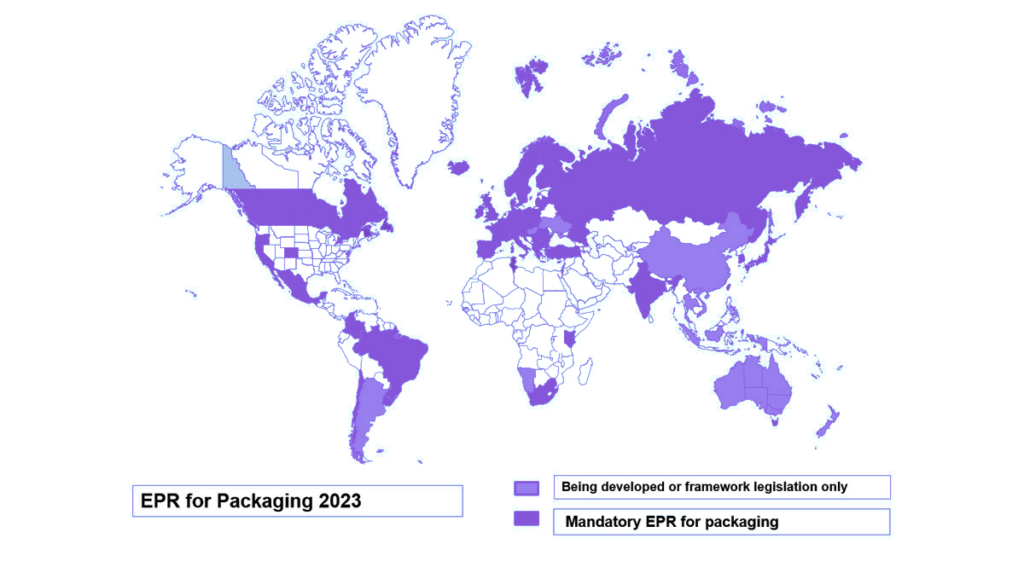In case you missed it, as we’ve entered 2024, we are now one year closer to extended producer responsibility (EPR) for packaging in the United States. But that’s not all. Extended producer responsibility laws are also evolving in Canada and there are major changes coming in the European Union.
If you sell a product that is in a package, as most are, please take a moment and read this update. Under EPR legislation, producers are defined broadly as the entity that places the packaging in the market which includes brands and importers.
A frequent question is “How do they define recyclable?” Details are provided below.
PART 3 – European Union
Under the Packaging and Packaging Waste Directive 94/62/EC of 1994 the member states of the European Union have been working to prevent the production of packaging waste through reuse, recycling and other means. However, the directive did not harmonise the approaches and created a suboptimal approach for the economic alliance.
With the European Green Deal and its subsequent Circular Economy Action Plan came the need to revisit the directive and create a standardised approach through a regulation. A draft regulation was published in 2022 that outlined requirements for the entire packaging life cycle and for extended producer responsibility. With a harmonised approach, Member States would not be allowed to prohibit, restrict, or impede the placing on the market of packaging that complies with the directive.
Fast forward to today and the regulation was adopted in Oct 2023 by European Parliament. Its scope covers all packaging and all packaging waste, regardless of origin.
The proposed definition of recyclable packaging includes packaging that is designed for material recycling and then collected, sorted and recycled at scale. The scale criterion will not take effect until 2035 to allow for an infrastructure build.
A major point of contention, especially in the recycling industry, is allowing bio-based plastics to be counted as a contributor to recycled content targets. Recyclers argue that bio-based should be separate from recycled as grouping them could diminish the importance of recycling as a means of creating a circular materials for packaging.
For plastic recyclers, the question of whether chemical recycling will fit into the definition of “recycling” or if chemically recycled plastics will count as “recycled content” is still unsettled.
The regulation also responds to a demand for clear labelling to ensure that consumers are well informed about the packaging materials and waste management instructions. The objective to have one harmonised label has been reshaped to allow for labelling systems that may already be in place.
Key Requirements of the proposed Packaging and Packaging Waste Regulation
| Requirement | Deadline |
|---|---|
| Minimise concentration of lead, cadmium, mercury, and hexavalent chromium in packaging materials (below 100 mg/kg) | As from adoption |
| Require all packaging to be fully recyclable at scale | From 1 January 2030 (although the recyclable at scale requirement comes into force 1 January 2035) |
| Require all plastic packaging to include a minimum amount of recycled content | Different targets per type of packaging starting from 1 January 2030 |
| Limit packaging weight and volume to the minimum level necessary to ensure functionality | 12 months after entry into force |
| Ban certain single-use plastic packaging formats | As of adoption |
| Design all packaging to be reusable | Different targets per industry starting from 1 January 2030 |
| Introduce uniform labels with information on material composition to facilitate and encourage customers to sort waste and to differentiate between different types of plastic packaging | 42 months after entry into force |
Download the PPWR guide
What remains is for the European Commission, European Council of Ministers, and the European Parliament to agree on a bill that can then be proposed for ratification. This process is expected to conclude before June 2024.
Here is a view of the global packaging EPR legislation development, as of 2023. EPR programs are also in place in Australia, Hong Kong, India, Japan, Russia, New Zealand, South Korea, among others.

Graphic source: Derek Stephenson, Strategy Matters
If this was interesting, you might want to review PART 1 – United States and PART 2 – Canada to review EPR initiatives in USA and Canada.
Coming Up Next
In PART 4 – Getting Prepared, We will offer a roadmap on how to you can get ready for EPR.
We are the world’s leading purpose driven, digitally enabled, science-based activator and always welcome inquiries and partnerships to drive positive change together.



